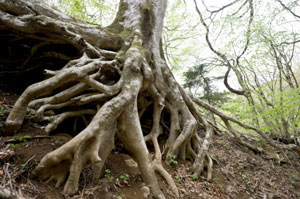Plants, fungi and rising levels of carbon dioxide

It is a fact that the level of carbon dioxide in the atmosphere has been rising. It has been monitored since 1956 at the Mauna Loa Observatory (MLO) in Hawaii. Mauna Loa was originally chosen as a carbon dioxide monitoring site because it is located far from any continent and offers a good average value for the air over the central Pacific.
Carbon dioxide (CO2) is an important trace gas in the Earth's atmosphere; its current level is about 400 parts per million (ppm). Despite its relatively low concentration, CO2 is a significant greenhouse gas. It plays a vital role in regulating the Earth's surface temperature. Research work and analysis of air bubbles in ancient ice sheets and marine sediments show that atmospheric carbon dioxide concentrations have varied, from as high as 7,000 ppm about 500 million years ago to a low of circa 180 ppm  during the Quaternary glaciation (about two million years ago). For much of recorded history and prior to the industrial revolution, the level was about 280 ppm.
during the Quaternary glaciation (about two million years ago). For much of recorded history and prior to the industrial revolution, the level was about 280 ppm.
Its current level of 400 ppm represents a significant increase and is probably the highest value for some 800,000 years. It has risen because of the burning of fossil fuels (which releases carbon dioxide) and the process of deforestation (less carbon dioxide being used up).
One might think that this increased level of carbon dioxide would offer ‘opportunities’ for plants as it is essential for the process of photosynthesis. It might be expected that with increasing levels of carbon dioxide, plants would use more in photosynthesis, giving more sugars for growth and the production of biomass. Indeed, this is the case for many plant species but not all
César Terrer, a postgrad at Imperial College, London and other researchers at the Universities of Antwerp, Indiana & New South Wales have found that enhanced growth is only possible when the plants had enough nitrogen. If nitrogen sources were limiting, increased levels of carbon dioxide had no effect. Exceptions to this were plants that had mycorrhizae.  Mycorrhizae are associations between fungi and the roots of certain trees (and other plants). Microscopic, tube-like fungal threads (hyphae) form a network around the roots of a tree. These are known as ectotrophic mycorrhizae and are different from the mycorrhizae seen in grasses and orchids - endotrophic forms). The mycorrhizal net takes and uses various carbohydrates from the tree that it has made in photosynthesis. However, the transfer is not one way; the tree benefits as it gains mineral nutrients (nitrates, phosphates etc) from the extensive network of fungal hyphae, which not only surround the roots but ramify through the soil – absorbing a variety of minerals.
Mycorrhizae are associations between fungi and the roots of certain trees (and other plants). Microscopic, tube-like fungal threads (hyphae) form a network around the roots of a tree. These are known as ectotrophic mycorrhizae and are different from the mycorrhizae seen in grasses and orchids - endotrophic forms). The mycorrhizal net takes and uses various carbohydrates from the tree that it has made in photosynthesis. However, the transfer is not one way; the tree benefits as it gains mineral nutrients (nitrates, phosphates etc) from the extensive network of fungal hyphae, which not only surround the roots but ramify through the soil – absorbing a variety of minerals.
As a result of their enhanced mineral nutrition, mycorrhizal plants show better growth and development when compared to non-mycorrhizal ones (of the same species), or indeed those with endotrophic mycorrhizae. For further information see : http://science.sciencemag.org/content/353/6294/72
Comments are closed for this post.

[…] indicated that plants can only take advantage of the increased carbon dioxide levels if they had sufficient nitrogen. The raised level of carbon dioxide has been acting like a ‘fertiliser’, promoting growth […]
Global warming and the changing seasons. | Woodlands.co.uk
8 December, 2016